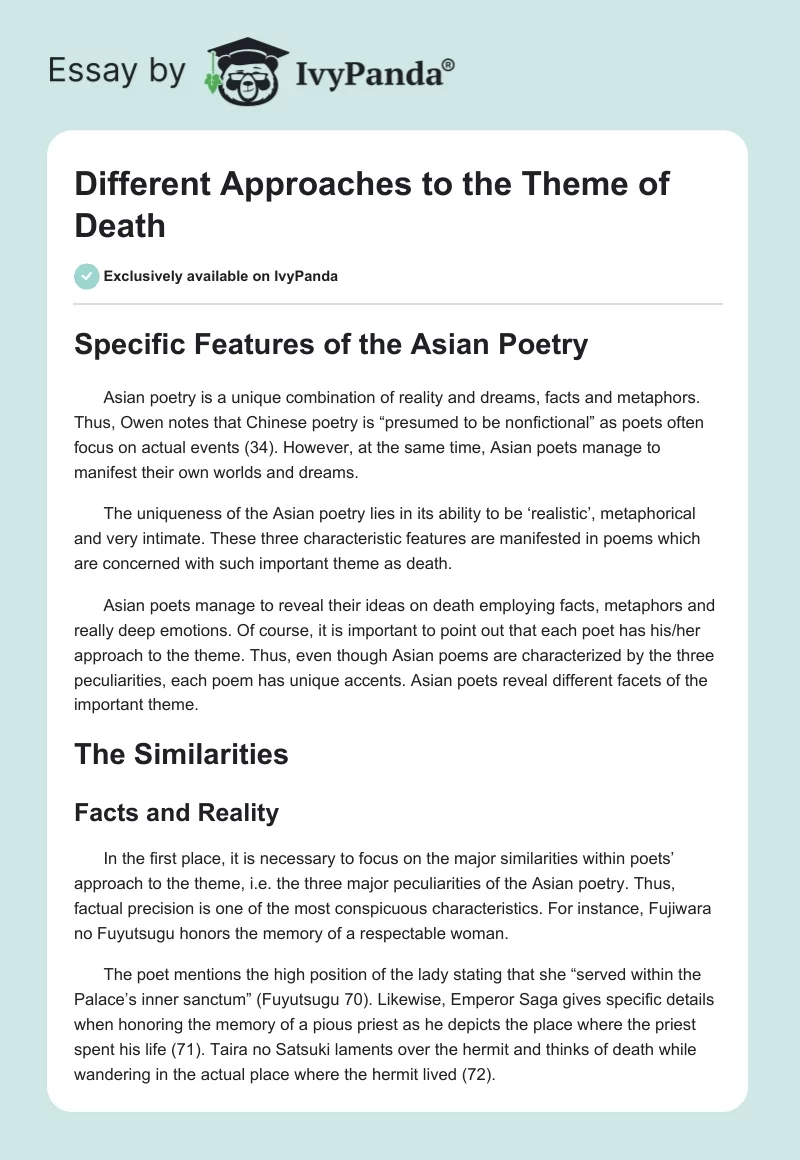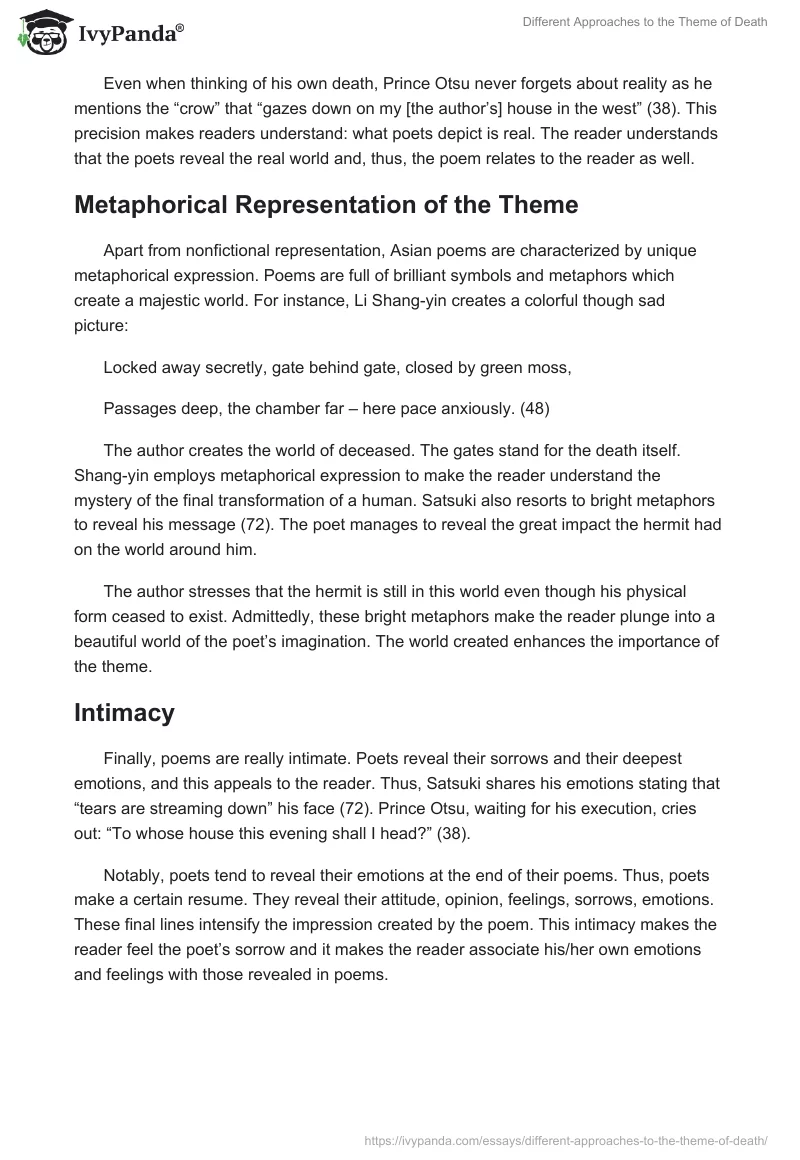Specific Features of the Asian Poetry
Asian poetry is a unique combination of reality and dreams, facts and metaphors. Thus, Owen notes that Chinese poetry is “presumed to be nonfictional” as poets often focus on actual events (34). However, at the same time, Asian poets manage to manifest their own worlds and dreams.
The uniqueness of the Asian poetry lies in its ability to be ‘realistic’, metaphorical and very intimate. These three characteristic features are manifested in poems which are concerned with such important theme as death.
Asian poets manage to reveal their ideas on death employing facts, metaphors and really deep emotions. Of course, it is important to point out that each poet has his/her approach to the theme. Thus, even though Asian poems are characterized by the three peculiarities, each poem has unique accents. Asian poets reveal different facets of the important theme.
The Similarities
Facts and Reality
In the first place, it is necessary to focus on the major similarities within poets’ approach to the theme, i.e. the three major peculiarities of the Asian poetry. Thus, factual precision is one of the most conspicuous characteristics. For instance, Fujiwara no Fuyutsugu honors the memory of a respectable woman.
The poet mentions the high position of the lady stating that she “served within the Palace’s inner sanctum” (Fuyutsugu 70). Likewise, Emperor Saga gives specific details when honoring the memory of a pious priest as he depicts the place where the priest spent his life (71). Taira no Satsuki laments over the hermit and thinks of death while wandering in the actual place where the hermit lived (72).
Even when thinking of his own death, Prince Otsu never forgets about reality as he mentions the “crow” that “gazes down on my [the author’s] house in the west” (38). This precision makes readers understand: what poets depict is real. The reader understands that the poets reveal the real world and, thus, the poem relates to the reader as well.
Metaphorical Representation of the Theme
Apart from nonfictional representation, Asian poems are characterized by unique metaphorical expression. Poems are full of brilliant symbols and metaphors which create a majestic world. For instance, Li Shang-yin creates a colorful though sad picture:
Locked away secretly, gate behind gate, closed by green moss,
Passages deep, the chamber far – here pace anxiously. (48)
The author creates the world of deceased. The gates stand for the death itself. Shang-yin employs metaphorical expression to make the reader understand the mystery of the final transformation of a human. Satsuki also resorts to bright metaphors to reveal his message (72). The poet manages to reveal the great impact the hermit had on the world around him.
The author stresses that the hermit is still in this world even though his physical form ceased to exist. Admittedly, these bright metaphors make the reader plunge into a beautiful world of the poet’s imagination. The world created enhances the importance of the theme.
Intimacy
Finally, poems are really intimate. Poets reveal their sorrows and their deepest emotions, and this appeals to the reader. Thus, Satsuki shares his emotions stating that “tears are streaming down” his face (72). Prince Otsu, waiting for his execution, cries out: “To whose house this evening shall I head?” (38).
Notably, poets tend to reveal their emotions at the end of their poems. Thus, poets make a certain resume. They reveal their attitude, opinion, feelings, sorrows, emotions. These final lines intensify the impression created by the poem. This intimacy makes the reader feel the poet’s sorrow and it makes the reader associate his/her own emotions and feelings with those revealed in poems.
The Differences
As has been mentioned above, the Asian poetry is characterized by certain similarities, but every poet has some specific approach to the theme. The major differences largely lie in the plane of specific facets of the theme touched upon in the poem. For instance, when thinking of death such poets as Fuyutsugu, Emperor Saga and Satsuki focus on dignity and great role the deceased played.
Their poems are concerned with honoring the memory of the deceased. Of course, they also lament over the loss. However, the major focus is made on the glory of the deceased.
On the contrary, Prince Otsu and Shang-yin focus on the anxiety people feel when facing death. The two poets contemplate the further path of the human. They also lament over the necessity to leave this world. The two poets focus on personal and intimate things. Admittedly, each facet is interesting to pay attention to. When it comes to Asian poets, the interest is doubled as the poets create marvelous and expressive worlds to wander.
Conclusion
On balance, it is necessary to note that the Asian poetry is a unique combination of incompatible qualities. Asian poets manage to create poems which have such characteristics as factual precision, metaphorical expression and intimacy.
At the same time, poems are absolutely different as even when dwelling upon similar themes poets use different approaches to it. Thus, such important theme as death has numerous facets to look at. Asian poets reveal all those facets. These specific features make the Asian poetry that unique and appealing as the reader opens up new horizons.
Works Cited
Emperor Saga. “A Lament for Priest Genpin.” Dance of the Butterflies: Chinese Poetry from the Japanese Court Tradition. Ed. Judith N. Rabinovitch. Ithaca, NY: Cornell University, 2005. 71. Print.
Fuyutsugu, Fujiwara. “A Verse to Match the Poem “A Lament for Lady-in-Waiting Ono”.” Dance of the Butterflies: Chinese Poetry from the Japanese Court Tradition. Ed. Judith N. Rabinovitch. Ithaca, NY: Cornell University, 2005. 70. Print.
Owen, Stephen. Traditional Chinese Poetry and Poetics: Omen of the World. Madison, Wis.: University of Wisconsin Press, 1985. Print.
Prince Otsu. “Near the End.” Dance of the Butterflies: Chinese Poetry from the Japanese Court Tradition. Ed. Judith N. Rabinovitch. Ithaca, NY: Cornell University, 2005. 38. Print.
Satsuki, Taira. “Visiting the Site Where the Hermit Used to Live.” Dance of the Butterflies: Chinese Poetry from the Japanese Court Tradition. Ed. Judith N. Rabinovitch. Ithaca, NY: Cornell University, 2005. 72. Print.
Shang-yin, Li. “At Ch’ung-jang House, in the First Month of the Year.” Traditional Chinese Poetry and Poetics: Omen of the World. Ed. Stephen Owen. Madison, Wis.: University of Wisconsin Press, 1985. 48. Print.


